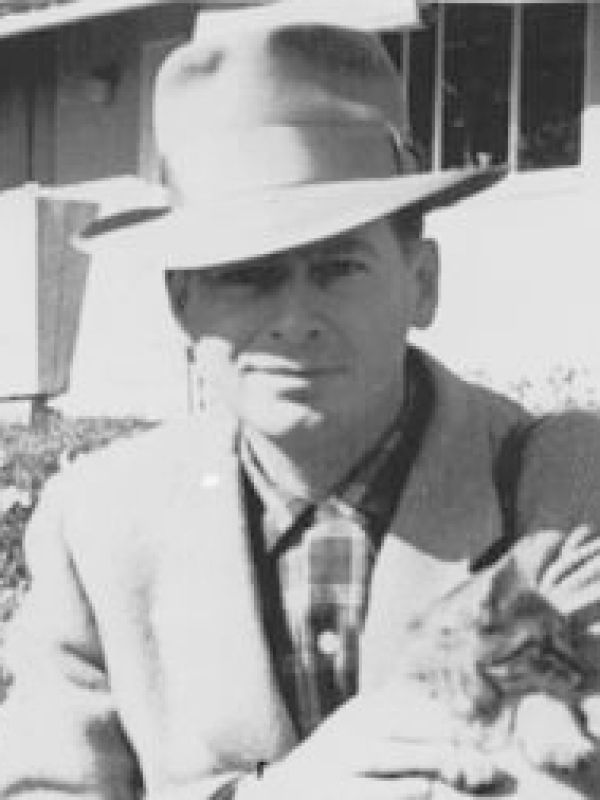Custer Charles Baum
Custer Charles Baum was my father. Custer was born in Helena, Montana on March 22, 1914, and passed suddenly at his home in Montecito very near to his loving wife, Persis Eugenia Baum, February 10, 1984. Persis passed March 22, 2010, devoted to Custer.
Custer was educated at Carroll College in Helena. Upon conferral of a bachelors in Mathematics, Custer came to California under a full Regents’ Scholarship to study Astronomy at the University of California. At Berkeley, he met his beloved wife Persis, who was also studying toward a doctorate in Astronomy, having completed a bachelors and masters in Mathematics at the Southern Branch of the University of California (now UCLA).
Custer completed his masters thesis on the color excesses of certain galactic star clusters in 1940. Custer and Persis were wed the same year in the Newman Chapel near UCLA. Custer and Persis had worked together at the Lick Observatory at Berkeley. The couple started a family of what to become five children with the birth of Eugene.
With the start of the US involvement in World War II, Custer was called back to the Naval Observatory in Washington, D.C. which led to being drafted into the Manhattan Project to develop nuclear deterrents against the Axis powers. Custer delighted in talking of those he had met, such as Johnny Von Neumann, Richard Feynman, as well as others.
Prior to the war, Custer had worked for Howard Hughes and developed a method of high speed photography where events transpiring in microseconds could be filmed which was patented by the Hughes Corporation. Though once top secret, many years later Custer described his role in the project.
At the center of a room surrounded by explosives sat a large steel ball. Though electricity travels at fast but finite speed, the object of the game was to simultaneously detonate the explosives so as to implode the steel ball. The steel ball not being Uranium, there was little nuclear hazard. A typical day, the steel ball would be knocked off its pedestal by a slight retardation of charge to one or another explosive. Custer’s role was to use his method of photography for filming the nanosecond order of detonation.
One day, Custer and a military officer entered the room following another trial. The steel ball was nowhere to be found, having imploded to dust. The settings or retardation of charge to explosives was simultaneous, and record had been kept of these settings. Immediately, the military officer ran out of the room to report to his superior. Implosion had been successful, and Custer had played his part in the war effort. Custer’s work was primarily in Ridgecrest, California, commuting home to Hawthorne through the desert.
Following the use of a nuclear bomb against Japan in order to make a show of force to Hitler, the Axis had begun to crumble, and thanks to, and at a loss of life or limb to, many Allied servicemen and Japan, the war was won. Custer signed a petition to President Harry S. Truman that nuclear power henceforth only be used for peaceful purposes.
Custer received an offer to teach at MIT (Massachusetts Institute of Technology) following his work at JPL (Jet Propulsion Laboratory) at the California Institute of Technology, however declined because Persis could not bear the eastern winters.
On their honeymoon, Custer and Persis stayed in a hotel in Santa Barbara near the highway which was later to become a freeway. They fell in love with Santa Barbara, and following Custer’s completing his doctoral dissertation at Berkeley in 1947, having had Peter and with Francis one year old, the couple moved in 1950 from Persis’s folks in Hawthorne to Santa Barbara where they had Richard and Mary.
Mr. Hughes had been kind and partially funded the start-up of Santa Barbara Research Center, of which Custer was President. This followed the start-up of Pacific Mercury in Santa Barbara by Custer, financed by several gentlemen near Los Angeles.
As an economist, Custer recommended I read the book Small is Beautiful by German born British economist E. F. “Fritz” Schumacher. Economics as if people mattered is how Custer led his life. Custer was a lifelong pacifist and member of the Third Order of St. Francis at the Old Mission. Custer retired in 1972 after having started his last company, the Te Company on Montecito Street. Custer said Te was the Japanese God of War. Perhaps Te did the Te Company in, as defense contracts were beginning to disappear.
Custer was preceded in death by his brother-in-law Clyde Eugene Fell, his sister Luella Baum, and followed in death by his brother Edgar (Isabelle) Baum, wife Persis Eugenia (nee Fell) Baum, and eldest son Eugene Custer (Sandra) Baum. Custer is survived by sons Peter Joseph (Elaine) Baum, Francis Jesse (Eileen) Baum, Richard Anthony (Melanie) Baum and daughter Mary Persis (Eric Cantlay) Baum, as well as granddaughters Katrina (Paul) Stone, Maryann Joy Baum, Stephanie (Saul) Gonzalez, grandson Kevin A. Baum, great-granddaughters Leanne Gonzalez and Sophia Stone, nephew John Baum, nieces Theresa Shelley and Margaret (John) Doyle and grand-nieces Megan, Ashley, Alissa and Claire.
In loving memory, Richard Anthony Baum

